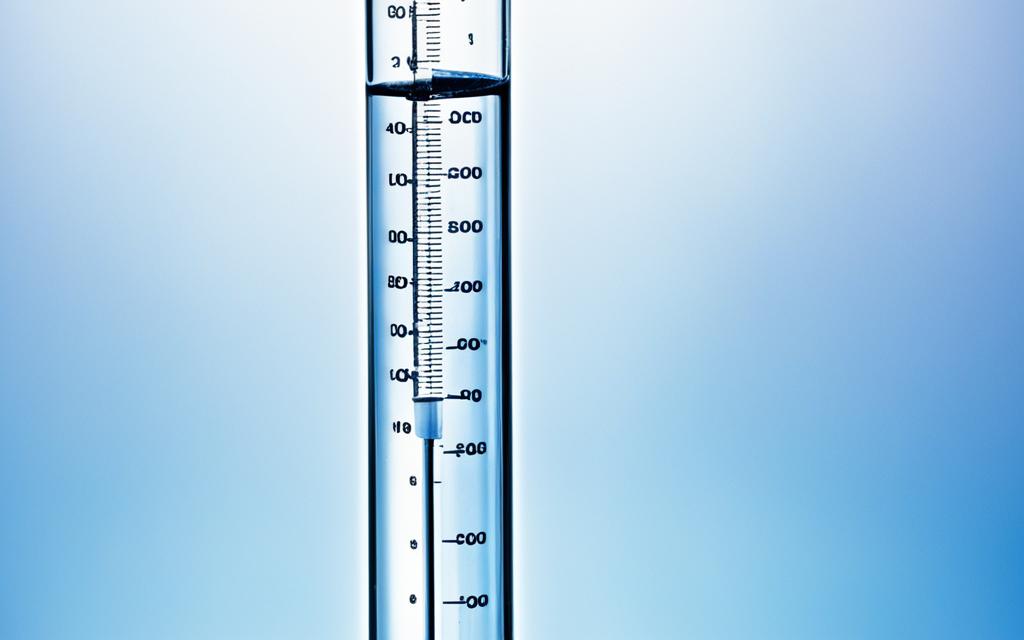Have you ever wondered how to precisely determine the density or specific gravity of a liquid? The answer lies in the humble yet powerful instrument known as the hydrometer. This compact and versatile tool is widely used across various industries, from brewing and distilling to wastewater treatment and manufacturing, to provide valuable insights into the properties and composition of different liquids.
The hydrometer relies on the principles of buoyancy to measure the relative density of a liquid. When placed in a liquid, the hydrometer will float, and the depth to which it sinks will provide a direct indication of the liquid’s density. This simple yet effective measurement technique allows you to gain a deeper understanding of the substances you work with, whether you’re a homebrewer, an environmental scientist, or a quality control manager.
What is a Hydrometer?
A hydrometer is a compact, cylindrical instrument typically consisting of a weighted, sealed bulb at the bottom and a calibrated stem or scale at the top. When placed in a liquid, the hydrometer will float, with the depth of immersion determined by the density of the liquid. The scale on the stem is calibrated to provide a direct reading of the relative density or specific gravity of the liquid.
Hydrometers can be made of glass, plastic, or metal, and come in various sizes and ranges to accommodate different types of liquids and applications. The versatility of the hydrometer makes it a valuable tool for a wide range of industries, from brewing and distilling to wastewater treatment and quality control in manufacturing processes.
| Hydrometer Component | Description |
|---|---|
| Bulb | The weighted, sealed bottom portion of the hydrometer that allows it to float in the liquid being measured. |
| Stem | The calibrated upper portion of the hydrometer that displays the scale and provides the direct density or specific gravity reading. |
| Scale | The markings on the stem of the hydrometer that are calibrated to indicate the relative density or specific gravity of the liquid. |
| Calibration | The process of ensuring the accuracy of the scale on the hydrometer, often by comparing it to a known standard. |
Principles of Hydrometer Function
The working principle of a hydrometer is based on Archimedes’ principle of buoyancy. When the hydrometer is placed in a liquid, it experiences an upward buoyant force proportional to the weight of the liquid displaced. The deeper the hydrometer sinks, the greater the volume of liquid displaced and the higher the buoyant force. This relationship between the depth of immersion and the liquid’s density allows the hydrometer’s scale to provide a direct reading of the specific gravity or relative density of the liquid.
By comparing the hydrometer’s readings to known values, you can determine the composition or concentration of a liquid. The principle of buoyancy is the key to understanding how a hydrometer works, as it allows the instrument to measure the density and specific gravity of various liquids with precision.
Common Uses of Hydrometers
Hydrometers have a diverse range of applications across various industries. In the brewing and distilling sectors, hydrometers play a crucial role in measuring the specific gravity of wort and fermented liquids. This data provides valuable insights into the alcohol content and sugar levels of these beverages, enabling brewers and distillers to optimize their processes and ensure product quality.
Beyond the world of alcohol production, hydrometers are also extensively used in wastewater and environmental testing. By measuring the density of water samples, these instruments help assess water quality and monitor pollution levels, contributing to the efforts of environmental scientists and regulatory authorities to maintain the integrity of our natural resources.
In the manufacturing industry, hydrometers are employed for quality control purposes, ensuring the consistency and precise composition of various liquid products, such as acids, solvents, and oils. This application helps manufacturers uphold high standards of product quality and maintain the trust of their customers.
| Industry | Hydrometer Application | Key Measurements |
|---|---|---|
| Brewing and Distilling | Measure specific gravity of wort and fermented liquids | Alcohol content, sugar levels |
| Wastewater and Environmental Testing | Measure density of water samples | Water quality, pollution levels |
| Manufacturing | Ensure consistency and composition of liquid products | Acid, solvent, and oil properties |
Across these diverse industries, the hydrometer remains an indispensable tool, providing crucial data and insights that enable professionals to optimize their processes, maintain quality standards, and address critical environmental concerns.
Choosing the Right Hydrometer
When selecting a hydrometer, it’s crucial to pick the one that best suits the specific application and properties of the liquid you need to measure. Hydrometers come in a variety of scales, such as specific gravity, Baumé, and Brix, each designed for different types of liquids and industries.
The scale and range of the hydrometer should match the expected density or concentration of the liquid to ensure accurate readings. Additionally, factors like the liquid’s temperature, viscosity, and chemical composition may influence the choice of hydrometer, as some instruments are better suited for specific types of liquids.
To make an informed selection, consider the following key factors:
| Factor | Consideration |
|---|---|
| Liquid Properties | Match the hydrometer scale and range to the expected density or concentration of the liquid. |
| Temperature | Ensure the hydrometer can accommodate the expected temperature range of the liquid. |
| Viscosity | Choose a hydrometer designed for liquids with specific viscosity characteristics. |
| Chemical Composition | Select a hydrometer that is compatible with the chemical properties of the liquid. |
By considering these factors, you can select the hydrometer that will provide the most accurate and reliable readings for your specific application and liquid properties.
Proper Hydrometer Use and Care
To obtain reliable and accurate readings from a hydrometer, it’s essential to use and maintain the instrument properly. Proper calibration, which often involves comparing the hydrometer’s readings to a known standard, is crucial to ensure accurate measurements. Additionally, temperature can affect the density of liquids, so temperature correction factors may need to be applied to the hydrometer readings. Keeping the hydrometer clean and free from debris is also important to prevent inaccurate measurements and extend the instrument’s lifespan.
Before using a hydrometer, it’s important to ensure that it is properly calibrated. This can be done by comparing the hydrometer’s readings to a known standard, such as distilled water at a specific temperature. If the hydrometer’s readings are not within the expected range, it may need to be adjusted or replaced.
Temperature can also have a significant impact on the density of liquids, and therefore, the readings from a hydrometer. To ensure accurate measurements, it’s important to apply temperature correction factors to the hydrometer’s readings. This can be done by using a temperature conversion chart or by consulting the manufacturer’s instructions.
Proper cleaning and maintenance of the hydrometer is also crucial to maintain its accuracy and longevity. After each use, the hydrometer should be rinsed with clean water and allowed to dry completely before being stored. Avoiding the use of harsh chemicals or abrasives can help preserve the integrity of the instrument.
| Hydrometer Best Practices | Description |
|---|---|
| Calibration | Compare hydrometer readings to a known standard to ensure accuracy |
| Temperature Correction | Apply temperature adjustment factors to account for changes in liquid density |
| Cleaning | Rinse the hydrometer with clean water and dry completely after each use |
| Storage | Store the hydrometer in a safe, dry place to protect it from damage |
By following these best practices for hydrometer use and care, you can ensure that your measurements are accurate and reliable, allowing you to make informed decisions based on the data you collect.
Advanced Applications of Hydrometers
Beyond the common uses of hydrometers in industries like brewing, distilling, and wastewater treatment, there are also more specialized applications that leverage the instrument’s capabilities. For instance, the oil and gas sector utilizes specialized hydrometers designed to measure the density of specific fluids, such as crude oil or refined petroleum products.
Additionally, the integration of hydrometers with digital technologies, such as smartphone apps and wireless data transmission, has opened up new possibilities for remote monitoring, data analysis, and real-time process control in various industries. This digital integration of hydrometers allows for more efficient and comprehensive tracking of liquid properties, enabling better decision-making and optimization of industrial processes.
These advanced applications of hydrometers demonstrate the versatility and potential of this simple yet powerful instrument. As technology continues to evolve, we can expect to see even more specialized types of hydrometers and innovative ways to incorporate them into diverse industries and applications.
Conclusion
In the world of liquids, the humble hydrometer stands as a powerful tool, offering a wealth of insights into the very nature of the fluids that surround us. Whether you’re a homebrewer fine-tuning your craft, an environmental scientist monitoring water quality, or a quality control manager ensuring the consistency of your products, the hydrometer is an indispensable instrument that can unlock a deeper understanding of the density and specific gravity of liquids.
By mastering the principles of hydrometer function, learning about its diverse applications, and selecting the right instrument for your needs, you can harness the power of this simple yet versatile device to make informed decisions and drive continuous improvement across a wide range of industries. From brewing and distilling to wastewater treatment and manufacturing, the hydrometer’s ability to provide accurate, reliable data is a testament to its importance in the world of liquid analysis.
As you continue to explore the many facets of the hydrometer, remember that it is not just a tool, but a gateway to a deeper appreciation of the liquids that shape our world. By leveraging the insights it provides, you can unlock new possibilities, optimize your processes, and make a meaningful impact in your field. So, embrace the hydrometer, and let it guide you on your journey of discovery, unlocking the secrets hidden within the liquids that surround us.










